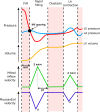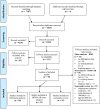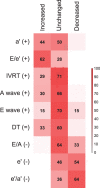The effect of overweight/obesity on diastolic function in children and adolescents: A meta-analysis
- PMID: 34278720
- PMCID: PMC8767098
- DOI: 10.1111/cob.12476
The effect of overweight/obesity on diastolic function in children and adolescents: A meta-analysis
Abstract
Left ventricular diastolic function (LVDF) is an important marker of early cardiovascular remodelling, which has not been well summarized in young people with overweight/obesity. Weighted, random-effects regression was used to determine the strength of associations of both body mass index (BMI) and homeostatic model assessment of insulin resistance (HOMA-IR) with LVDF measures, adjusting for age and sex. Six databases were searched after PROSPERO registration (CRD42020177470) from inception to July 2020 for studies that compared LVDF between overweight/obesity and control groups aged ≤24 years, yielding 70 studies (9983 individuals). Quality and risk of bias were assessed using NHLBI tools, with scores of good, fair, and poor for 6, 48, and 16 studies, respectively. Increased BMI was associated with worse LVDF in all measures except early mitral inflow deceleration time, with septal early diastolic tissue peak velocity to late diastolic tissue peak velocity ratio having the strongest association (n = 13 studies, 1824 individuals; r = -0.69; P < 0.001). Elevated HOMA-IR was also associated with worse LVDF. Although we could not determine the causality of reduced LVDF in young people, our findings should aid the development of paediatric guidelines for the assessment of LVDF and support further work to address the longitudinal consequences of childhood obesity and IR on LVDF.
Keywords: children; diastolic function; obesity.
© 2021 The Authors. Clinical Obesity published by John Wiley & Sons Ltd on behalf of World Obesity Federation.
Conflict of interest statement
The authors have no conflicts of interest relevant to this article to disclose.
Figures




References
-
- Finkelstein EA, Graham WC, Malhotra R. Lifetime direct medical costs of childhood obesity. Pediatrics. 2014;133(5):854‐862. - PubMed
-
- Agmon Y, Oh JK, McCarthy JT, Khandheria BK, Bailey KR, Seward JB. Effect of volume reduction on mitral annular diastolic velocities in hemodialysis patients. Am J Cardiol. 2000;85(5):665‐668. A611. - PubMed
Publication types
MeSH terms
Grants and funding
LinkOut - more resources
Full Text Sources
Medical

